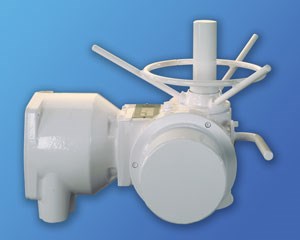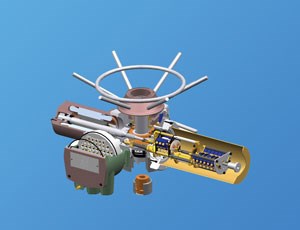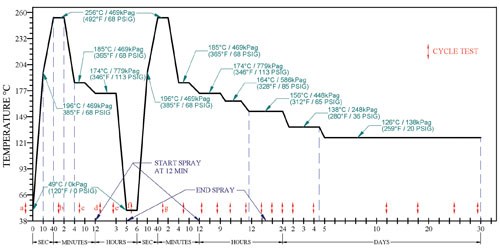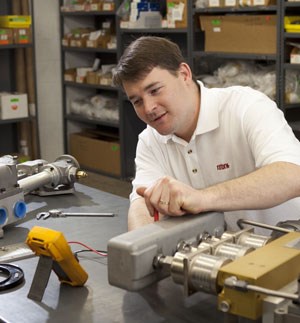Actuation in Nuclear Power Plants
The thousands of actuators used in a nuclear plant face some pretty tough conditions as well as rigorous testing.
#actuators
Currently, 104 nuclear power-plant reactors are working in the United States, and all of them have operating environments that are extremely challenging. Of those 104 plants, 35 are classified as boiling and 69 as pressurized water reactors.
While the design details vary from plant to plant, each nuclear facility has thousands of valve actuators used in various processes and applications. The newest-generation nuclear plant has more than 13,000 valves.
It’s clear, then, that valve actuators play vital roles in maintaining process safety, efficiency and productivity in a wide range of situations.
This article contains a brief description of some of the special circumstances encountered in challenging nuclear environments and the different styles of actuators used to meet demanding operational and safety requirements.
STRICT GUIDELINES AND REQUIREMENTS
To understand basic requirements the nuclear power industry faces in this nation, a review of the similarities and differences between nuclear power and fossil power is helpful.
In a fossil power plant, coal might be crushed and mixed with air to boil water, which produces steam to drive a turbine. With nuclear reactions, the process is different, but the operational objective is essentially the same—to heat water to produce steam to drive a turbine. With a coal steam generator, the activity of burning the pulverized coal and producing steam is contained within what is termed the “boiler island.” Because of the strong similarity to what happens in the coal plant, many engineers and technicians in a nuclear plant refer to the area where steam generation occurs as the “nuclear island.”
To be suitable for service in a nuclear reactor, an actuator must go through specific testing by outside testing agencies. The test reports produced must then be reviewed not only by the actuator suppliers, but by consulting engineers and the utilities themselves. Many documents also are reviewed by the NRC.
The tests for actuators used “inside containment” apply to all styles. The plants use electric motor operators as well as pneumatic cylinder actuators and hydraulic cylinder actuators. All of these actuators must be tested to ensure they can withstand the environment for their expected lives. Also, in addition to environmental concerns, the actuators must be able to operate during extreme accident conditions such as an earthquake.
THE TESTING PROCESS
The certification process puts the actuator through a simulated life test where it is aged seismically, environmentally and mechanically. In other words, the actuator is exposed to the normal radiation and temperatures it would experience in over 40 years of operating in a nuclear plant, and it is stroked as many times as expected over that time period. When it is shown to be at the end of its expected life, it is then put through the most rigorous test of all, which is known as the loss of coolant accident (LOCA) test.
The LOCA test simulates a Design Basis Event (DBE), such as an earthquake, in which the severity would vary depending on where the plant was located. During the test, the actuator is exposed multiple times to extreme temperature variations up to 500° F (260° C). It also might be sprayed with various caustic materials and/or be required to stroke to ensure it can operate under those conditions. The bottom line is that very few safety-related actuators have the integrity to pass this sort of testing, but whether the safety-related actuator is pneumatic or electric, it has to be able to survive the stipulated LOCA test requirements to serve inside containment.
Another issue regarding nuclear actuators concerns the designation of “active” with regards to safety systems. When a situation occurs in which a safety system needs to be invoked, such as ensuring coolant water is available for the reactor, actuators required to operate to deliver that water are part of the safety system. These actuators are then classified as “active” as they may be required to operate during or after a DBE. Thus, even when equipment is not within the inside containment area itself, if it is considered active, it must go through stringent testing to ensure reliability.
The seismic and environmental tests can take 12 to 18 months to complete. Once the actuator is qualified to work within this environment, another important step is taken.
Although actuators are used on dampers in heating, ventilation and air conditioning systems, many actuators are operating valves inside the containment building. The valves have their own standards because they are pressure containment devices. To operate in those areas, the valves must carry what is known as the “N” stamp, and the tests of valves associated with the “N” stamp are demanding and arduous.
Sometimes, the “N” stamp testing terminology causes confusion as far as how it relates to actuators. Actuators by themselves have no “N” stamp. Instead, they have a pedigree based on various testing results over many years. Reviewing and evaluating the numerous test reports is how a determination is made as far as whether or not an actuator can be used for an application.
When a qualified actuator with the appropriate pedigree is mated to an “N” stamp valve, the integral unit must pass one more important test. This test is to assure the “N” stamp valve combined with the approved attached actuator has sufficient integrity to withstand difficult seismic requirements. The test is governed by another standard known as QME-1. Although it is essentially a valve test, the actuator is an important component so it is part of the testing.
WHEN AND WHERE EQUIPMENT CAN BE USED
As explained, only the most rugged actuators manufactured today are suitable for use inside a nuclear reactor. When equipment is not part of the safety system and it is outside of the reactor, standard industrial equipment can be used that takes advantage of some of today’s newer technologies.
An example is smart actuators. The modern electric actuator used in many process plants today consists of an integral motor control center with a digital control module. That configuration allows remote monitoring of valve and actuator data useful for maintenance and diagnostics. Unfortunately, the technology of today does not allow these sophisticated electronics to reside within an actuator or to pass the environmental and seismic testing required for inside the reactor. Actuators with advanced technology can only be used in applications that do not require active testing.
ENHANCEMENTS UNDER STRINGENT TESTING
Because motor operators are very simple with just a motor, gear set, and limit and torque switches within robust cast iron and steel housing, some advanced options are available that can assist the nuclear industry in certain applications.
For example, several major actuator manufacturers offer a thrust monitoring component so the nuclear plant can monitor valve thrust requirements and actuator thrust outputs. While that capability is a standard item with a smart actuator, it’s not as simple with the nuclear actuator. The typical way this capability is achieved in a nuclear actuator is by measuring the deflection of the motor shaft via the spring pack on the end of the motor.
Another example of a nuclear option becoming very popular is the torque limiter. When sizing an actuator for a valve in a nuclear application, the criteria are different than for most other applications. The valve factors used to calculate the thrust required are very high so sufficient safety margins are ensured. The safety margins are set by the industry and monitored very closely.
Another factor that comes into play is power voltage. The actuators must be sized to work on reduced voltages that might be available during accident conditions. When a motor is running on reduced voltage, it produces reduced torque. The combination of these challenges means an actuator might be much larger for a valve than normally used.
Motor operators are also very powerful and have a reserve torque and thrust capability. The industry calls them stall torques, and they can more than double the rated output torque of an actuator. Because of the demands, the associated valve must have a stronger superstructure as well as a larger stem than what might be expected. The larger stem then might require a larger thrust, and the exact balance becomes a challenge for specifying engineers.
The torque limiter is a brake that will reduce the force put on the valve during abnormal operation so that the valve does not need as large a structure to hold the actuator. Another option used for high-speed valve applications is thrust compensators, which are essentially disc spring packs that allow for a gradual loading of the actuator as the valve seats.
PNEUMATIC PISTON/ HYDRAULIC/DIAPHRAGM/ MANUAL
Various nuclear plant applications use pneumatic piston operators. In many cases, spring-return actuators are used when the valve must fail to a position on loss of air supply. In other cases, nitrogen-charged accumulators can power the cylinders to achieve the desired failure position. Often, these actuators are used in critical applications, such as to operate main steam isolation valves. Typically, such pneumatic spring-return actuators will have very fast operating times with many redundant sets of controls to ensure operation during a plant shutdown.
Pneumatic spring-return actuators can be constructed of ductile iron, cast iron or steel and have to pass the same difficult tests as their electric counterparts. Because the controls for pneumatic actuators tend to be bolted onto the cylinder and gearbox housings, these controls usually require their own IEEE testing. Once the controls are mounted to the cylinders, they are tested as a dedicated package.
The cylinders themselves can also be hydraulically powered. Because of the compressibility of air, hydraulics can provide more precise control than pneumatics. However, hydraulics can add cost and complexity to a system. Also, hydraulic equipment could require more maintenance during its life because of the nature of the sealing surfaces with cylinders.
To best meet the needs of nuclear customers, many manufacturers of hydraulic actuation equipment offer maintenance programs to assist utilities in keeping equipment up to date and in line with current qualifications and standards, which is an important goal of every well-run nuclear facility.
Nuclear plants also have a need for traditional quarter-turn cylinder actuators to operate the growing population of quarter-turn valves in their facilities. For example, rubber-seated butterfly valves for water service are used extensively as well as the more industrial-service butterfly valves. In the past, electric actuators were often employed, but today, with the addition of more high-pressure severe service quarter-turn valves in the market, many of these valves are provided with spring-return, quarter-turn cylinders and are mainly pneumatic.
Inside the containment, there is still a large population of diaphragm-operated control valves. The actuators tend to be an integral part of the valve in this case. While pneumatic actuators are the norm for this application in nuclear plants, many industrial process plants are starting to look at the use of electric actuators to operate various control valves. Also, interest is growing among new plant designers for electric solutions for modulating service particularly where instrument air is difficult to provide or maintain.
Finally, no nuclear plant would be complete without a large number of manual gear operators. If these operators are in critical areas, they also need to be seismically tested and qualified. This can be difficult since the gears can be quite large, which makes finding shaker tables for seismic testing big enough to handle those gears a challenge. Bevel, spur and worm gears also are all used in various nuclear applications.
SUMMARY
Because of the hundreds of different valve-actuator applications in a nuclear facility, it’s essential that those involved in specifying and maintaining such equipment work closely with reputable actuator manufacturers to determine the best solution for each situation.
Safety, efficiency, meeting the appropriate standards and longevity are all crucial issues that need to be considered for each and every valve actuator installed in a nuclear plant.
Pete Kundin is general manager of the Eastern USA business unit, Rotork, Rochester, NY. (www.rotork.com). Reach Kundin at pete.kundin@rotork.com.
RELATED CONTENT
-
Grease for Motor Actuator Maintenance
Maintaining the right amount of grease inside motor actuators that use grease for lubrication is a vital part of valve maintenance, and can save time and money by preventing problems before they happen.
-
Understanding Torque for Quarter-Turn Valves
Valve manufacturers publish torques for their products so that actuation and mounting hardware can be properly selected.
-
New Requirements for Actuator Sizing
After decades of confusion, the American Water Works Association has created new standards for actuator sizing that clear up some of the confusion and also provide guidance on where safety factors need to be applied.












 Unloading large gate valve.jpg;maxWidth=214)


